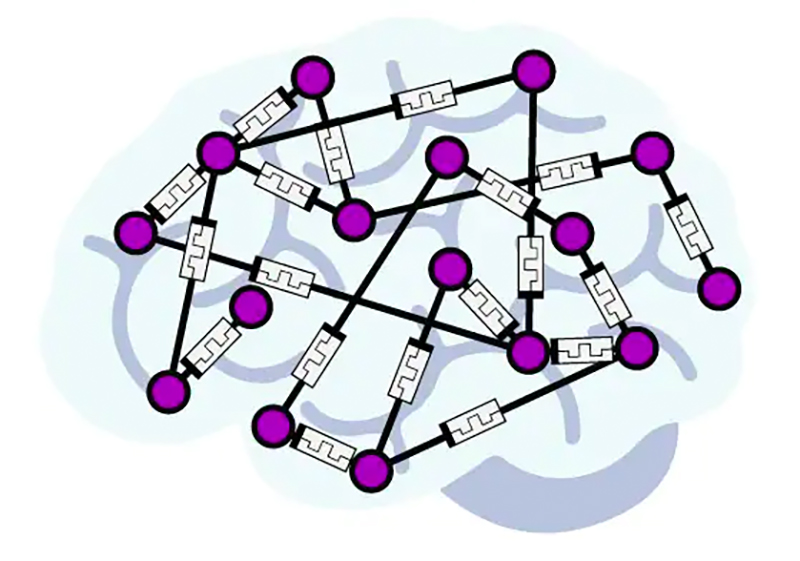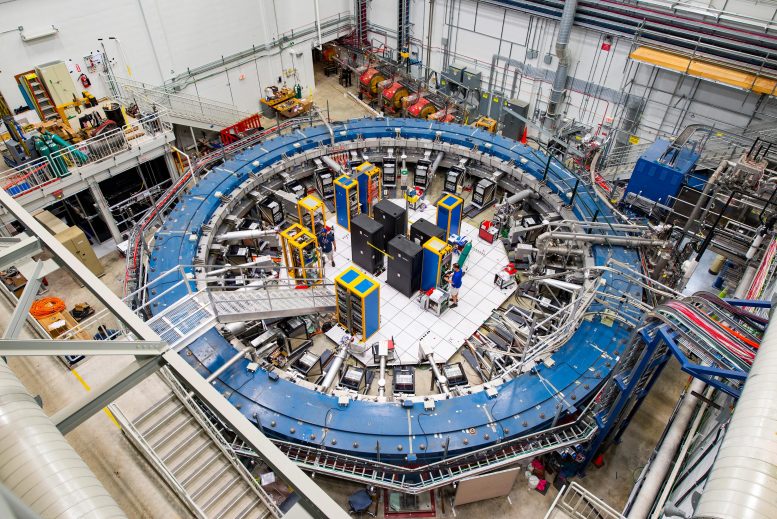Saturday, July 17
The Edge of Chaos
The team used varying levels of electricity on a nanowire simulation, finding a balance when the electric signal was too low when the signal was too high. If the signal was too low, the network's outputs weren't complex enough to be useful; if the signal was too high, the outputs were a mess and also useless.
"We found that if you push the signal too slowly the network just does the same thing over and over without learning and developing. If we pushed it too hard and fast, the network becomes erratic and unpredictable," says physicist Joel Hochstetter from the University of Sydney and the study's lead author.
Keeping the simulations on the line between those two extremes produced the optimal results from the network, the scientists report. The findings suggest a variety of brain-like dynamics could eventually be produced using nanowire networks.
 Conceptual image of randomly connected switches. (Alon Loeffler)
Conceptual image of randomly connected switches. (Alon Loeffler)"Some theories in neuroscience suggest the human mind could operate at this edge of chaos, or what is called the critical state," says physicist Zdenka Kuncic from the University of Sydney in Australia. "Some neuroscientists think it is in this state where we achieve maximal brain performance."
For the simulations, nanowires 10 micrometers long and no thicker than 500 nanometers were arranged randomly on a two-dimensional plane. Human hairs can be up to around 100,000 nanometers wide, for comparison. TO READ ENTIRE ARTICLE, CLICK HERE...
Profound Implications
The Muon g-2 experiment hosted at Fermi National Accelerator Laboratory announced on April 7 that they had measured a particle called a muon behaving slightly differently than predicted in their giant accelerator. It was the first unexpected news in particle physics in years.
Everyone’s excited, but few more so than the scientists whose job it is to spitball theories about how the universe is put together. For these theorists, the announcement has them dusting off old theories and speculating on new ones.
“To a lot of us, it looks like and smells like new physics,” said Prof. Dan Hooper. “It may be that one day we look back at this and this result is seen as a herald.”
Gordan Krnjaic, a fellow theoretical physicist, agreed: “It’s a great time to be a speculator.”
The two scientists are affiliated with the University of Chicago and Fermilab; neither worked directly on the Muon g-2 experiment, but both were elated by the results. To them, these findings could be a clue that points the way to unraveling the last mysteries of particle physics—and with it, our understanding of the universe as a whole.

Based on century-old experiments and theories going back to the days of Albert Einstein’s early research, scientists have sketched out a theory of how the universe—from its smallest particles to its largest forces—is put together. This explanation, called the Standard Model, does a pretty good job of connecting the dots. But there are a few holes—things we’ve seen in the universe that aren’t accounted for in the model, like dark matter.
No problem, scientists thought. They built bigger experiments, like the Large Hadron Collider in Europe, to investigate the most fundamental properties of particles, sure that this would yield clues. But even as they looked more deeply, nothing they found seemed out of step with the Standard Model. Without new avenues to investigate, scientists had no idea where and how to look for explanations for the discrepancies like dark matter.
Then, finally, the Muon g-2 experiment results came in from Fermilab (which is affiliated with the University of Chicago). The experiment reported a tiny difference between how muons should behave according to the Standard Model, and what they were actually doing inside the giant accelerator. TO READ ENTIRE ARTICLE, CLICK HERE...
A Digital Euro
FROM THE ASSOCIATED
PRESS...
The European Central Bank said Wednesday it is launching a two-year investigation on whether to introduce a digital version of the euro that would complement cash, taking a cautious step toward introduction as central bankers around the world eye digital currencies and their potential impact on policy and the financial system.
The ECB said in a statement that the digital euro must be able to meet consumers’ needs while helping prevent illegal activity such as money laundering and must not have an adverse impact on financial stability and monetary policy.
Digitalization “is reaching all areas of our lives,” Fabio Panetta, a member of the ECB’s executive board, wrote in a blog post. “The coronavirus (COVID-19) pandemic has shown just how fast such change can happen. And this is affecting the way we pay. We are increasingly buying digitally and online.”
He said that there were many questions to be answered and that “a decision about whether or not to issue a digital euro will only come at a later stage.” If the idea gets a green light at the end of two years, it would take three more to actually develop the digital euro. TO READ ENTIRE ARTICLE, CLICK HERE...
Friday, July 16
A Routine of Routines
For the next 3 weeks, I have no doctor's appointments or treatments of anykind except an unexpected trip to the clinic, I suppose should anything out-of-the-ordinary arise with which might cause me some concern.
My tasks because weekly maintenance of the yard, trash, recycle, and the cleaning of the pool, along with daily activities of hygiene, writing and posting articles and/or poems, blog maintenance, and adding to my in progress novels, of which I currently have 4, but can obviously only focus on one at a time.
There are no out-of-town vacation plans scheduled nor are there any plans to go to restaurants although we will no doubt go out for breakfast or brunch at least once a week.
Outside of watching FOX News in the mornimg, for me, the television screen will remain off and there are no plans or desire to stream anything to my cell phone or laptop or tablet.
Our 3 cats pretty much take care of themselves durimng the day, except when they take a notion that they need attention and/or food and then become a pestering pet until I get up off of my dead ass and do something for them.
My health remains stable and good and I will always spend a couple of hours every other day to prepare some type of meal that will last me 2-3 days with the focus being on squash, zucchini, tomatoes, or cucumbers out of our garden.
Our Consciousness
What’s going on in your head right now? Presumably you’re having a visual experience of these words in front of you. Maybe you can hear the sound of traffic in the distance or a baby crying in the flat next door. Perhaps you’re feeling a bit tired and distracted, struggling to focus on the words on the page. Or maybe you’re feeling elated at the prospect of an enlightening read. Take a moment to attend to what it’s like to be you right now. This is what’s going on inside your head.
Or is it? There’s another, quite different story. According to neuroscience, the contents of your head are comprised of 86 billion neurons, each one linked to 10,000 others, yielding trillions of connections.
A neuron communicates with its neighbour by converting an electrical signal into a chemical signal (a neurotransmitter), which then passes across the gap in between the neurons (a synapse) to bind to a receptor in the neighbouring neuron, before being converted back into an electrical signal. From these basic building blocks, huge networks of electro-chemical communication are built up. TO READ ENTIRE ARTICLE, CLICK HERE...
Fireflies Sync Their Flashes
“Above that threshold, it is almost perfect synchronization,” with rhythmic, coordinated waves of light, said Sarfati, a postdoctoral associate at the University of Colorado, Boulder.
The spontaneous synchronization of certain species of fireflies, such as Photinus carolinus in the Great Smoky Mountains in North Carolina and Tennessee, has long baffled humans who observed the peculiar mating ritual, in which blinking males strive to attract the attention of ground-level females.
In the past 50 years, scientists collected anecdotal observations of these unified flashes but not enough empirical data to truly study firefly synchronization’s mechanisms.
Now, Sarfati and Orit Peleg, a physicist and assistant professor also at the University of Colorado, have filmed the mating hordes of P. carolinus and mapped their flashing patterns in three-dimensional space.














